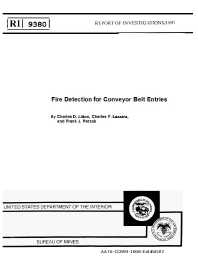Mining Publication: Fire Detection for Conveyor Belt Entries
Original creation date: January 1991
This U.S. Bureau of Mines report details the results of a series of large-scale experiments where small coal fires were used to ignite the conveyor belt at air velocities ranging from 0.76 to 6.1 M/s. In the tests, electrical strip heaters imbedded within a pile of coal were used to heat the coal to a point of flaming ignition. The flaming coal subsequently ignited the conveyor belt located approximately 5 to 10 cm above the coal pile. During the tests, temperature, CO, and smoke levels were continuously measured in order to determine both alarm time and level as the fire intensity progressed through the stages of smoldering coal, flaming coal, and flaming coal plus flaming belt. Analysis of the data leads to certain conditions of air velocity and sensor alarm levels that are required for early detection of conveyor belt entry fires. Two nomographs are presented, which define sensor alarm levels and sensor spacings as a function of belt entry cross-sectional area and belt entry air velocity.
Authors: CD Litton, CP Lazzara, FJ Perzak
Report of Investigations - January 1991
NIOSHTIC2 Number: 10011046
Pittsburgh, PA: U.S. Department of the Interior, Bureau of Mines, RI 9380, 1991 Jan; :1-23
See Also
- Comparative In-Mine Evaluation of Carbon Monoxide and Smoke Detectors
- A Comparison of Mine Fire Sensors
- Evaluation of a Signaling and Warning System for Underground Mines
- Evaluation of Smoke and Gas Sensor Responses for Fires of Common Mine Combustibles
- Fire Control and Suppression
- In Mine Evaluation of Discriminating Mine Fire Sensors
- In-Mine Evaluation of Smart Mine Fire Sensor
- In-Mine Evaluation of Underground Fire and Smoke Detectors
- Mine Fire Source Discrimination Using Fire Sensors and Neural Network Analysis
- Overview of Mine Fire Detection
- Rapid Detection and Suppression of Mining Equipment Cab Fires
- Content source: National Institute for Occupational Safety and Health, Mining Program


 ShareCompartir
ShareCompartir
